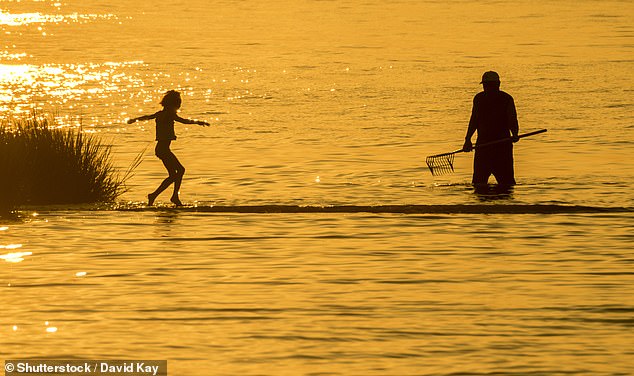Flesh-eating bacteria are invading once untouched US beaches as climate change heats up East Coast oceans – and infections have increased five-fold
- Water surface temperatures have been rising year-over-year since 1901
- Flesh-eating, water-dwelling Vibrio bacteria prefer warmer water
- Until recently, the Delaware Bay was too cold for infections – which typically strike those with weakened immune systems – to occur there
- Between 2008 and 2016, Cooper University Hospital in New Jersey saw just one flesh-eating Vibrio infection
- In just two summers in 2017 and 2018, the same hospital saw five infections that killed on person and left another a quadruple amputee
- Doctors there are warning that more of these potentially deadly infections can be expected in previously unaffected areas as climate change continues
Flesh-eating bacteria may soon be coming to a beach near you as climate change fuels the spread of the feared bugs in once-safe oceans, a new study suggests.
Five people in Delaware and New Jersey have contracted flesh-eating infections in the last two years from seafood or water from the Delaware Bay, which used to be too cold for the microorganisms.
But as water temperatures rise, beaches along the Northeast Coast may become comfortable homes for the bacteria Vibrio vulnificus – and more more dangerous ones for humans.
The researchers from the University of the Sciences in Philadelphia and Cooper University Hospital warn that many beaches may soon be unsafe for people with weakened immune systems or open wounds.

Crabbing is a popular activity in the Delaware Bay (pictured). As the water warms, both the sea and the seafood become more dangerous as flesh-eating bacteria flourish. In 2017-2018, New Jersey doctors at one hospital saw five infections, compared to one in the eight years prior
A number of kinds of bacteria can become necrotizing, or ‘flesh-eating.’
The most common water-borne one is Vibrio vulnificus, a bacteria species that lives in brackish (mixed fresh and salt) water and prefers a warm climate.
Typically, these bacteria need water to have a surface temperature above 13 C (55.4 F) to thrive, and infections are most common in the waters surrounding states like Texas, Florida, Louisiana and Florida.
Currently, the water temperatures of the entire Delaware Bay is well over 60 degrees.
That’s becoming a more common occurrence in the once-cold waters of the East Coast in general and the Delaware Bay in general.
On average, the sea surface temperatures have risen by 0.13 F every decade since 1901.
It might not be enough for us to notice when we return to beaches after a winter away from the water, but those creeping temperature make a big difference to bacteria.
And, anecdotally, scientists are seeing signs of their growing populations.
According to the new study, doctors at Cooper University Hospital, in Camden, New Jersey, near the bay, saw just one case of Vibrio between 2008 and 2016.
But in just two summers – 2017 and 2018 – the same hospital saw five cases, which they presented in their new report.
One of the patients, a 64-year-old man, died after he developed an irregular heartbeat during a third attempt to remove the dying flesh from his badly-infected right arm.
The other four survived, but only barely in some of their cases.
Another patient, a 60-year-old man with Parkinson’s disease, first came to the hospital with severely swollen leg, which the doctors had to cut open just to relieve pressure from.
But the infection spread rapidly, leaving him in shock and shutting down his respiratory system.
Doctors were able to save the man’s life, but only by amputating all four of his limbs.
The other three patients were more fortunate, escaping the ordeals with their lives – but not without aggressive treatment, including debridement, the often painful removal of dead, dying or infected flesh.
Those patients were a 38-year-old with untreated hepatitis C, a severely obese 46-year-old with type two diabetes, and a 64-year-old who also had untreated hepatitis C, as well arthritis he was on steroids for and an alcohol misuse disorder.
All five men had one thing in common.
They had all been crabbing – a popular pastime, sport and way of feeding oneself in the region – cleaning crabs or eating crabs prior to contracting Vibrio infections.
Most people acquire Vibrio by eating contaminated seafood or shellfish or by wading in water teeming with the bacteria while they have an open wound, cut or sore.
However, people are typically only vulnerable to the infection if their immune systems are already compromised – as was the case for four out of five of the patients seen at Cooper University Hospital.
Only the quadruple amputee had no obvious predisposition to the infection, but doctors speculated the 12 crabs he ate and the long wait time before he was treated allowed the infection to overwhelm the man’s otherwise healthy immune system.
The study authors are warning that they don’t believe these five gruesome cases are coincidences.
‘Climate change has resulted in significant increases in sea surface temperatures in many regions of the United States over the past 3 decades,’ they write.
‘These changes have resulted in longer summer seasons and are associated with alterations in the quantity, distribution, and seasonal windows of bacteria in marine ecosystems, including Vibrio species.
‘As a result of our experience, we believe that clinicians should be aware of the possibility that V vulnificus infections are occurring more frequently outside traditional geographic areas.’
